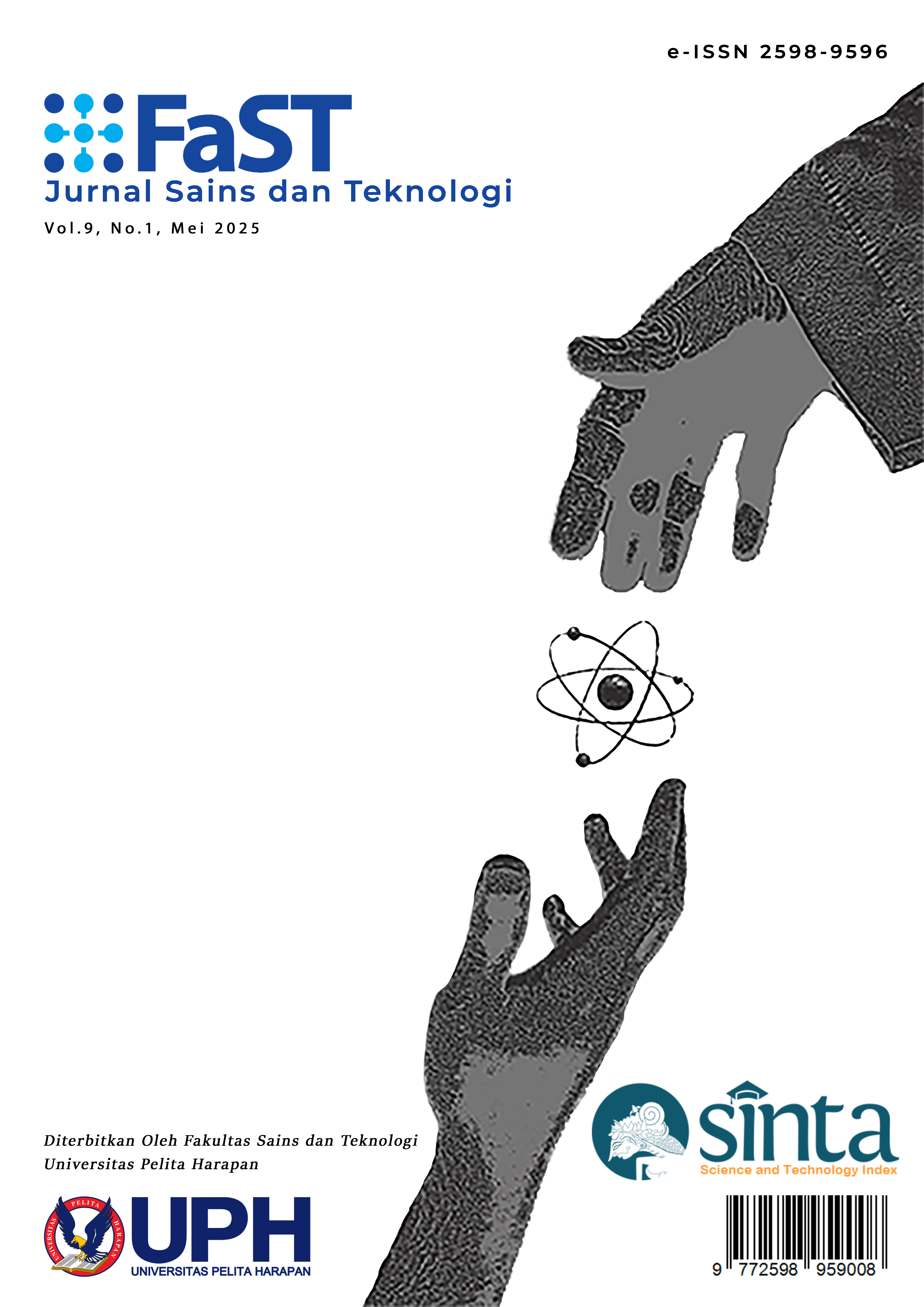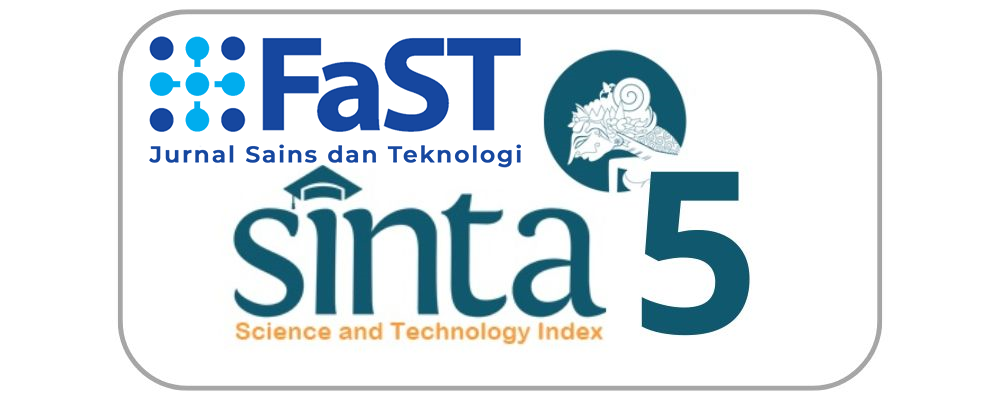Karakteristik Mikroenkapsulat Minyak Buah Merah (Pandanus conoideus Lam.) Berdasarkan Rasio Core to Coating pada Metode Gelasi Ion
[Characteristics of Red Fruit Oil Microencapsulates (Pandanus conoideus Lam.) Based on Core to Coating Ratio at Ion Gelation Method]
DOI:
https://doi.org/10.19166/jstfast.v9i1.9654Keywords:
CCR, ionic gelation, microencapsulation, red fruit oi, carotenoidAbstract
Red fruit oil has high carotenoid content which has the potential as a natural pigment. Microencapsulation with ion gelation method is one of method that can be used to protect carotenoid compounds which are naturally sensitive to light, oxygen, and high temperatures. The successful of the encapsulation process can be seen from the characteristics of the product and its encapsulation efficiency. The purpose of this study was to determine the effect of the core to coating ratio (CCR) on carotenoid efficiency and the characteristics of red fruit oil microencapsulation with the ionic gelation method using chitosan and STPP coating materials and their storage stability.fruit oil. In the preliminary stage is characterization of red fruit oil and the emulsion. In the main stage, red fruit oil microcapsules were made with variations of core to coating ratio (1:1, 1:2, 1:3, 1:4) and analyzed on the 1st and 11th days. Core to coating ratio affects water content, solubility, encapsulation efficiency, total carotenoids, carotenoid retention, antioxidant activity and stability, particle size, and color. Microencapsulates with a core to coating ratio of 1:1 gave the best results with 6.94±0.61% water content, 8.76±0.38% solubility, 67.89±5.72% encapsulation efficiency, 141.39±18.10 µg/g total carotenoid content, 83.31±2.75% carotenoid retention, 49.05±1.44 mg AAE/100 g antioxidant activity, and the value of °Hue 53.26 which shows a yellowish red color. The results of the particle size test showed a particle diameter of 1.5838 µm with a Polydispersity Index value of 0.374.
Bahasa Indonesia Abstract: Minyak buah merah memiliki kandungan karotenoid tinggi yang berpotensi sebagai pewarna alami. Mikroenkapsulasi dengan metode gelasi ion merupakan salah satu cara yang dapat digunakan untuk melindungi senyawa karotenoid yang secara natural bersifat sensitif terhadap cahaya, oksigen, dan suhu tinggi. Kesuksesan proses enkapsulasi dapat dilihat dari karakteristik produk dan efisiensi enkapsulasinya. Tujuan dari penelitian ini adalah untuk mengetahui pengaruh rasio core to coating (CCR) terhadap efisiensi karotenoid dan karakteristik mikroenkapsulat minyak buah merah dengan metode gelasi ionik menggunakan bahan penyalut kitosan dan STPP serta stabilitas penyimpanannya. Pada tahap pendahuluan dilakukan karakterisasi minyak buah merah yang digunakan dan emulsinya. Pada tahap utama dilakukan pembuatan mikroenkapsulat minyak buah merah dengan rasio core to coating (1:1, 1:2, 1:3, 1:4) dan dianalisis pada hari ke-1 dan ke-11. Rasio core to coating berpengaruh terhadap kadar air, kelarutan, efisiensi enkapsulasi, total karotenoid, retensi karotenoid, kapasitas antioksidan dan stabilitasnya, ukuran partikel, serta warna. Mikroenkapsulat dengan rasio core to coating 1:1 memberikan hasil terbaik dengan kadar air 6,94±0,61%, kelarutan 8,76±0,38%, efisiensi enkapsulasi 67,89±5,72%, kandungan total karotenoid 141,39±18,10 μg/g, retensi karotenoid 83,31±2,75%, kapasitas antioksidan 49,05±1,44 mg AAE/100 g, serta nilai °Hue 53,26 yang menunjukkan warna merah kekuningan. Hasil uji ukuran partikel menunjukkan diameter partikel sebesar 1,58 μm dengan nilai Polydispersity Index 0,374.
References
AOAC. 2005. Official methods of analysis of the Association of Official Analytical Chemists International. AOAC International
Belkhodja, H., Bouhadi, D., Medjadel, B., dan Brakna, A. 2021. Physicochemical characterization and evaluation of the antioxidant activities of essential oil extracted from Eucalyptus globulus. European Journal of Biological Research, 11(3): 315-324. http://www.journals.tmkarpinski.com/index.php/ejbr/article/view/450
Da Rosa, C. G., Borges, C. D., Zambiazi, R. C., Rutz, J. K., da Luz, S. R., Krumreich, F. D., Benvenutti, E. V., dan Nunes, M. R. 2014. Encapsulation of the phenolic compounds of the blackberry (Rubus fruticosus). Lwt, 58(2), 527–533. https://doi.org/10.1016/j.lwt.2014.03.042
Djafar F, Supardan MD. 2019. Pengaruh penyalut maltodekstrin terhadap produk mikrokapsul minyak jahe dengan teknik spray drying. Jurnal Litbang Industri, 9(1) : 1-7.
Dipahayu, D., dan Kusumo, G. G. 2021. Formulasi dan Evaluasi Nano Partikel Ekstrak Etanol Daun Ubi Jalar Ungu (Ipomoea batatas L.) Varietas Antin-3. Jurnal Sains dan Kesehatan, 3(6), 781–785. https://doi.org/10.25026/jsk.v3i6.818
Ferdiansyah, F., Heriyanto, H., Wijaya, C. H., Limantara, L., Ilmu, D., Pertanian, F. T., dan Bogor, I. P. 2017. Pengaruh Metode Nanoenkapsulasi terhadap Stabilitas Pigmen Karotenoid dan Umur Simpan Minyak dari Buah Merah (Pandanus conoideus L). Agritech, 37(4), 369–376
Fithriani, D., Amini, S., Melanie, S., dan Susilowati, R. 2015. Uji Fitokimia, Kandungan Total Fenol dan Aktivitas Antioksidan Mikroalga Spirulina sp., Chlorella sp., dan Nannochloropsis sp. Jurnal Pascapanen dan Bioteknologi Kelautan dan Perikanan, 10(2), 101. https://doi.org/10.15578/jpbkp.v10i2.270
Hasibuan, R., Dian, I., dan Marbun, S. 2018. Effectiveness of Various Desiccants and Air Velocity on Adsorption of Water Vapor From Air. Jurnal Teknik Kimia USU, 7(1).
Hasrini, R. F., Zakaria, F. R., Adawiyah, D. R., dan Suparto, I. H. 2017. Mikroenkapsulasi Minyak Sawit Mentah Dengan Penyalut Maltodekstrin Dan Isolat Protein Kedelai. Jurnal Teknologi dan Industri Pangan, 28(1), 10–19. https://doi.org/10.6066/jtip.2017.28.1.10
Ho, L. P., Pham, A. H., dan Le, V. V. M. 2015. Effects of Core/Wall Ratio and Inlet Temperature on the Retention of Antioxidant Compounds during the Spray Drying of Sim (Rhodomyrtus tomentosa) Juice. Journal of Food Processing and Preservation, 39(6), 2088–2095. https://doi.org/10.1111/jfpp.12452
Jayanudin, J., dan Rochmadi, R. 2017. Pengaruh Perbedaan Bahan Penyalut Terhadap Efisiensi Enkapsulasi Oleoresin Jahe Merah. ALCHEMY Jurnal Penelitian Kimia, 13(2), 275–287. https://doi.org/10.20961/alchemy.v13i2.5406
Kumar, V., Mathela, C. S., Kumar, M., dan Tewari, G. 2019. Antioxidant potential of essential oils from some Himalayan Asteraceae and Lamiaceae species. Medicine in Drug Discovery, 1, 100004. https://doi.org/10.1016/j.medidd.2019.100004
Kusumaningtyas, R., dan Leenawaty, L. 2019. Isomerisasi Dan Oksidasi Senyawa Karotenoid Dalam Buah Kelapa Sawit Selama Pengolahan Cpo The Isomerization And Oxidation Of Carotenoid Compounds In The Oil Palm. Indo. J. Chem, 9(November), 48–53.
Lee, P. E., dan Choo, W. S. 2015. Characterization of flaxseed oil emulsions. Journal of Food Science and Technology, 52(7), 4378. https://doi.org/10.1007/S13197-014-1495-3
Lusiana, R. A., Ahmad, S., Khabibi, dan Faradina, G. 2021. Pengaruh Tripolifosfat sebagai Agen Taut Silang pada Membran Kitosan Terhadap Karakter Fisikokimia dan Kemampuan Permeasi. Journal Environmental Chemistry, 1(1), 19–24.
Maryam, S., Baits, M., dan Nadia, A. 2016. Pengukuran Aktivitas Antioksidan Ekstrak Etanol Daun Kelor(Moringa oleifera Lam.) Menggunakan Metode FRAP (Ferric Reducing Antioxidant Power). Jurnal Fitofarmaka Indonesia, 2(2), 115–118. https://doi.org/10.33096/jffi.v2i2.181
Murtiningrum, Sarungallo, Z. L., dan Roreng, M. K. 2011. Kandungan Komponen Aktif Minyak Kasar Dan Hasil Degumming dari Buah Merah ( Pandanus conoideus ) yang Diekstrak Secara Tradisional. September.
Ningsih, N., Yasni, S., dan Yuliani, S. 2017. Sintesis Nanopartikel Ekstrak Kulit Manggis Merah Dan Kajian Sifat Fungsional Produk Enkapsulasinya. Jurnal Teknologi dan Industri Pangan, 28(1), 27–35. https://doi.org/10.6066/jtip.2017.28.1.27
Pratiwi, I., Sarungallo, Z. L., dan Santoso, B. 2020. Sifat Fisikokimia MBM (Pandanus conoideus Lamk.) Degumming dan Karakteristik Mikroenkapsulat MBM yang Dihasilkan. Agritechnology, 3(2),50.https://doi.org/10.51310/agritechnology.v3i2.54
Purnamayati, L., Dewi, E. N., dan Kurniasih, R. A. 2016. Karakteristik Fisik Mikrokapsul Fikosianin Spirulina Pada Konsentrasi Bahan Penyalut Yang Berbeda. Jurnal Teknologi Hasil Pertanian, 9(1), 1–8. https://doi.org/10.20961/jthp.v9i2.12844.
Rohman, A., Sugeng, R., dan Man, C. 2012. Characterizaton of red fruit (Pandanus conoideus Lam) oil. International Food Research Journal, 19(2): 563-567.
Saadah, M., Nurdiana, N., dan Wahyudiati, D. 2018. Uji Kadar Zat Warna (β-karoten) Pada Cabe Merah (Capsicum annum. Linn) sebagai Pewarna Alami. Biota: Jurnal Tadris IPA Biologi FITK IAIN Mataram, 9(1), 86–95. https://doi.org/10.20414/jb.v9i1.40
Sarungallo, Z. L., Hariyadi, P., dan Andarwulan, N. 2014. Pengaruh Metode Ekstraksi Terhadap Mutu Kimia dan Komposisi Asam Lemak MBM (Pandanus Conoideus). Eko Hari Purnomo J Tek Ind Pert, 24(3), 209–217.
Sarungallo, Z. L., Murtiningrum, dan Paiki, N. P. 2011. Sifat Fisikokimia Minyak Kasar dan Hasil Degumming dari Buah Merah (Pandanus conoideus L.) yang diekstrak secara Tradisional Merdey. Jurnal Agrotek, 1(6), 9–15.
Sarungallo, Z. L., Santoso, B., Roreng, M. K., dan Murni, V. 2019. Karakteristik Mutu Mikroenkapsulat MBM (Pandanus conoideus) Dengan Perbandingan Konsentrasi Bahan Pengemulsi dan Bahan Pelapis. Jurnal Ilmu dan Teknologi Pangan, 5(2), 528–539.
Shaygannia, S., Eshaghi, M. R., Fazel, M., dan Hashemiravan, M. 2021. The Effect of Microencapsulation of Phenolic Compounds from Lemon Waste by Persian and Basil Seed Gums on the Chemical and Microbiological Properties of Mayonnaise. Preventive Nutrition and Food Science, 26(1), 82–91. https://doi.org/10.3746/PNF.2021.26.1.82
Sucianti, Nurhaeni, dan Hardi, J. 2020. Mikroenkapsulasi Ekstrak Kulit Buah Naga Super Merah (Hylocereus costaricensis) pada Berbagai Massa Maltodekstrin dan Aplikasinya Sebagai Antioksidan. KOVALEN: Jurnal Riset Kimia, 6(3), 191–197. https://doi.org/10.22487/kovalen.2020.v6.i3.9889
Thamaket, P., dan Raviyan, P. 2015. Preparation and physical properties of carotenoids encapsulated in chitosan cross-linked tripolyphosphate nanoparticles. Food and Applied Bioscience Journal, 3(1), 69–84.
Ulumi, M. L. N. N., Wirandhani, D. S., Ardhani, R. F., Andhani, C. O., dan Putri, D. N. 2021. Mikroenkapsulasi Pigmen Beta-Karoten Dengan Metode Foam Mat Drying Menggunakan Gelatin Tulang Ikan Kakap Merah Sebagai Bahan Penyalut. J. Teknologi Industri Pertanian, 15(4), 1183–1195. https://doi.org/10.21107/agrointek.v15i4.11689
Wardani, A. D., Susanto, E., Dewi, E. N., dan Purnamayati, L. 2020. Pengaruh Perbedaan Pre-Treatment Terhadap Stabilitas. Jphpi, 23, 236–247.
Willy, Y., Widjanarko, S. B., dan Wahono, T. 2007. Karakteristik Dan Stabilitas Antioksidan Mikrokapsul MBM (Pandanus conoideus Lam) Dengan Bahan Penyalut Berbasis Protein. Jurnal Teknologi Pertanian, 8, 127–135.
Windarti, T., dan Dewi, A. 2022. Kitosan Termodifikasi Tripolifosfat Sebagai Kandidat Material Pelapis Artefak Kayu Tripolyphosphate Modified Chitosan As A Candidate For Wood Artifacts Coating Materials. Borobudur, XVI(1), 39–50.
Yanuwar W, Widjanarko SB, dan Wahono T. 2007. Karakteristik dan stabilitas antioksidan mikrokapsul MBM (pandanus conodeus) dengan bahan penyalut protein. Fakultas Teknologi Pertanian, Universitas Brawijaya. Jurnal Teknologi Pertanian, 8(2): 127-135
Downloads
Published
Issue
Section
License
Copyright (c) 2025 Titri Siratantri Mastuti, Angela Michelle Gunawan

This work is licensed under a Creative Commons Attribution-ShareAlike 4.0 International License.
“Authors who publish with this journal agree to the following terms:
1) Authors retain copyright and grant the journal right of first publication with the work simultaneously licensed under a Creative Commons Attribution License (CC-BY-SA 4.0) that allows others to share the work with an acknowledgement of the work's authorship and initial publication in this journal.
2) Authors are able to enter into separate, additional contractual arrangements for the non-exclusive distribution of the journal's published version of the work (e.g., post it to an institutional repository or publish it in a book), with an acknowledgement of its initial publication in this journal.
3) Authors are permitted and encouraged to post their work online (e.g., in institutional repositories or on their website). The final published PDF should be used and bibliographic details that credit the publication in this journal should be included.”



